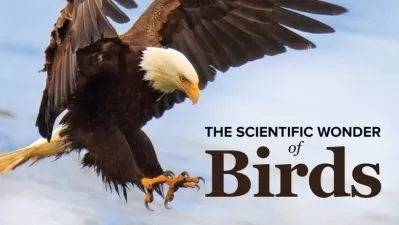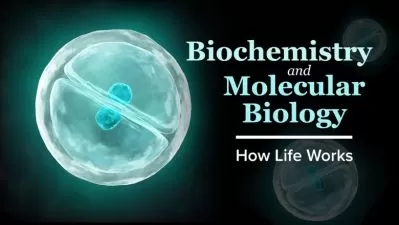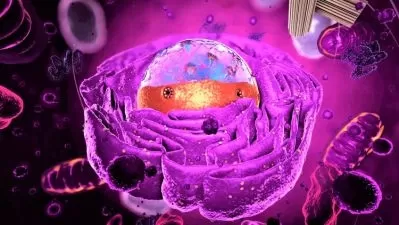BioGenius: Complete Guide to Biology Fundamentals | IGCSE
Omar Taha
11:18:09
Description
Complete | Animated | Updated | Detailed | Free notes | Affordable | 30-day refund policy
What You'll Learn?
- Define the characteristics of living organisms and describe how they are used to distinguish living from non-living things.
- Explain the importance of each characteristic in the context of living organisms.
- Describe the structure of prokaryotic and eukaryotic cells.
- Explain the functions of the different organelles within cells.
- Compare and contrast prokaryotic and eukaryotic cells.
- Define enzymes and their role in biochemical reactions.
- Describe the factors that affect enzyme activity.
- Explain the relationship between enzyme structure and function.
- Define the different types of nutrients required by living organisms.
- Explain the processes by which organisms obtain these nutrients.
- Describe the roles of different organs in digestion and absorption.
- Define cellular respiration and its importance to living organisms.
- Describe the processes of aerobic and anaerobic respiration.
- Explain the role of mitochondria in cellular respiration.
- Explain the need for transport of materials in living organisms.
- Describe the structure and function of the circulatory system in animals.
- Explain the relationship between structure and function in transport systems.
- Define homeostasis and its importance in living organisms.
- Describe the different mechanisms that help maintain homeostasis.
- Describe the structure and function of the nervous system.
- Describe the structure and function of the nervous system.
- Explain the role of hormones and the endocrine system in coordination.
- Describe the different types of stimuli and responses in living organisms.
- Describe the processes of sexual and asexual reproduction.
- Describe the processes of sexual and asexual reproduction.
- Explain the advantages and disadvantages of each type of reproduction.
- Describe the structure and function of reproductive organs.
- Define the laws of segregation and independent assortment.
- Explain how these laws relate to the inheritance of traits.
- Use Punnett squares to predict the outcomes of genetic crosses.
- Explain the causes and mechanisms of variation in living organisms.
- Describe the process of natural selection and its role in evolution.
- Provide examples of evidence for evolution, such as the fossil record and comparative anatomy.
Who is this for?
More details
DescriptionBiogenius: Biology for Standardized Tests is a complete and animated course based on the IGCSE curriculum. It is specifically designed to help students prepare for standardized biology tests including GCSE, AQA, and Oxford. The course is taught by an experienced instructor who has a deep understanding of the requirements of standardized biology tests.
This comprehensive course offers a complete and engaging learning experience, featuring animated videos, and practical examples. With easy-to-understand explanations and clear illustrations, students can learn essential biology concepts and skills that will help them excel on their exams.
The course covers all of the important topics in biology, including cells, genetics, ecology, and human biology. Each lesson includes interactive quizzes to test your knowledge and reinforce your learning. Whether you are a high school student preparing for an exam or someone who wants to improve their understanding of biology, this course has everything you need to succeed.
In conclusion, Biogenius: Biology for Standardized Tests is an excellent resource for students who want to excel on their standardized biology exams. The course is comprehensive, engaging, and taught by an experienced instructor. With its animated videos, interactive quizzes, and practical examples, it is the perfect way to learn and master essential biology concepts and skills.
Who this course is for:
- IGCSE Students of cambridge (CIE)
- Students who are interested in pursuing a career in the biological sciences, such as medicine, veterinary science, or environmental science.
- Students who want to develop their scientific literacy and critical thinking skills in biology.
- Students who are interested in learning about the structure and function of living organisms and how they interact with each other and their environment.
- Students who have completed a basic science curriculum and want to further their knowledge and understanding of biology.
- Students who are seeking an internationally recognized qualification that will prepare them for further study in biology or related fields.
Biogenius: Biology for Standardized Tests is a complete and animated course based on the IGCSE curriculum. It is specifically designed to help students prepare for standardized biology tests including GCSE, AQA, and Oxford. The course is taught by an experienced instructor who has a deep understanding of the requirements of standardized biology tests.
This comprehensive course offers a complete and engaging learning experience, featuring animated videos, and practical examples. With easy-to-understand explanations and clear illustrations, students can learn essential biology concepts and skills that will help them excel on their exams.
The course covers all of the important topics in biology, including cells, genetics, ecology, and human biology. Each lesson includes interactive quizzes to test your knowledge and reinforce your learning. Whether you are a high school student preparing for an exam or someone who wants to improve their understanding of biology, this course has everything you need to succeed.
In conclusion, Biogenius: Biology for Standardized Tests is an excellent resource for students who want to excel on their standardized biology exams. The course is comprehensive, engaging, and taught by an experienced instructor. With its animated videos, interactive quizzes, and practical examples, it is the perfect way to learn and master essential biology concepts and skills.
Who this course is for:
- IGCSE Students of cambridge (CIE)
- Students who are interested in pursuing a career in the biological sciences, such as medicine, veterinary science, or environmental science.
- Students who want to develop their scientific literacy and critical thinking skills in biology.
- Students who are interested in learning about the structure and function of living organisms and how they interact with each other and their environment.
- Students who have completed a basic science curriculum and want to further their knowledge and understanding of biology.
- Students who are seeking an internationally recognized qualification that will prepare them for further study in biology or related fields.
User Reviews
Rating
Omar Taha
Instructor's Courses
Udemy
View courses Udemy- language english
- Training sessions 183
- duration 11:18:09
- Release Date 2023/04/10











